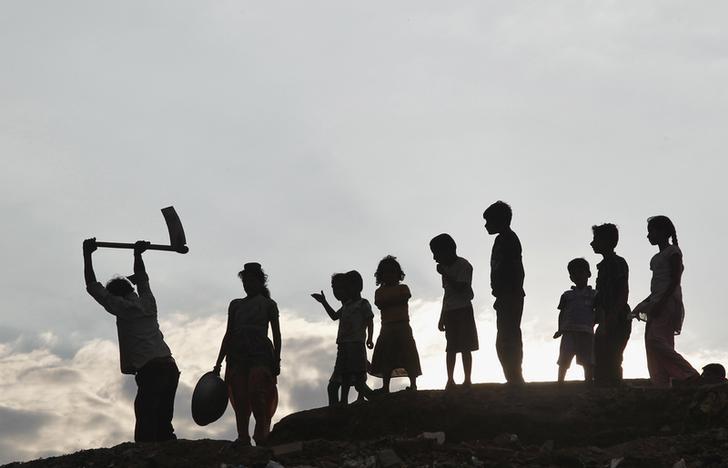New Delhi: A Delhi government’s survey has shown that there are as many as 2,21,694 children (or 9.76% of the total) in the age group of 6-17 who are out of school. Of them, 1,31,584 dropped out owing to various reasons, and 90,110 children have never attended school.
These worrying figures, as reported by the Indian Express, are a result of the state government survey covering 1.02 crore people, conducted in the one-year period between November 2018 and November 2019. The report, however, was finalised in November 2020, disclosing the socio-economic composition of the city, including details on religion, caste, income, education, chronic illnesses, status of vaccination, employment and preferred modes of transport.

Students in Delhi on their way to school. Photo: PTI
The main reason cited for not attending school by those in the age group of 6-17 years, according to the survey, is that they (29.2% of them) lack financial resources. On the other hand, 13.50% blamed it on being engaged in domestic duties, 12.17% cited that they had already achieved “desired education level”, and 9.37% of them being involved in economic activities.
Other socioeconomic indicators
While children in the age group of 0-6 years constitute 11.04% of Delhi’s population, only little more than half of them (55.40%) attend anganwadi centres. As for pregnant women over the age of 18 years, it has been found that 47.15% to be attending these centres, run by the Integrated Child Development Services (ICDS) programme of the government.
The survey has also shown that 47.31% households in Delhi spend Rs 10,000-Rs 25,000 per month, while 42.5% households have a monthly expenditure of Rs 10,000 or below. On the other hand, 8.44% households live on Rs 25,000-Rs 50,000 and a mere 1.66% on an income of Rs 50,000 and above, every month.
However, the per capita income of Delhi was Rs 3.89 lakh in 2019-20 (or over Rs 32,000 a month) — about three times the national average.
On the question of usage of computers and the availability of internet connections, it has been found that a little over 21% of the 20.05 lakh households surveyed use desktops or laptops. Of these, 80.15% households have an internet connection.
Also read: Thousands of Delhi Government School Students Face Being Pushed out of Education System
When it comes to availing of healthcare facilities, the survey has noted that a healthy 72.87% of the city’s population visit government hospitals and dispensaries for treatment. The remainder of the population relies on private facilities.

A resident of a slum near Sarai Rohilla Railway line, in New Delhi on September 13, 2020. Photo: PTI/Atul Yadav
Around 2.60% of the city’s total population has been found to be suffering from some kind of chronic illness. Of that figure, 36.33% population has been observed to have diabetes (43.34% in Central district), followed by 21.75% with cardiac illnesses (including hypertension and blood circulatory disease) and 9.17% have respiratory diseases.
In an important finding, at a time when Coronavirus vaccination is being rolled out, it has been found that as many as one-fourth of children in the age group of 0-5 years in Delhi have not received nor receiving any vaccination. In absolute numbers, out of 9.5 lakh children in the 0-5 age bracket, 2.13 lakh have not received any vaccination.
On the availability of water, it has been found that 70.98% people in Delhi have access to water within the household premises. Of that figure, 37.75% people in the South East district have access within their household premises, as opposed to 90% in Shahdara district.
At a more nuanced level, about 43.28% of the 1.86 lakh households in the South East district depend on bottled water, with the overall share being 7.76% in the total population. Of the total, 1.01 lakh households depend on tankers.
Also read: Watch | Delhi Slums Demolished, Leaving Hundreds Homeless
As for toilets, out of 20.5 lakh households, 18.7 lakh have toilets, 1.22 lakh use community toilets, and 11,497 households are known to fall under open defecation category.
Executed at a cost of Rs 26.61 crore, the survey report in the preface section states that previous sample surveys were unable to depict a real-time picture of requirements in terms of availability of infrastructure and social security.
“It was also felt by Delhi Government that due to lack of baseline data on various socio-economic indicators in respect of Households/Individuals of Delhi, a great deal of difficulty is being faced by different departments of Government of NCT of Delhi for policy formulation and implementation of schemes… It is expected that the data generated in this report will provide necessary information to policy makers, researchers and Government,” the Indian Express report quoted survey as saying.
The survey carried out by over 6,000 field workers was conducted in the aftermath of the backlash received following deaths of three minor girls of suspected starvation in East Delhi’s Mandawali in July 2018. It was found that the family did not have a ration card, and the investigation by the government authorities revealed that the local anganwadi centre had fudged records after the deaths.




